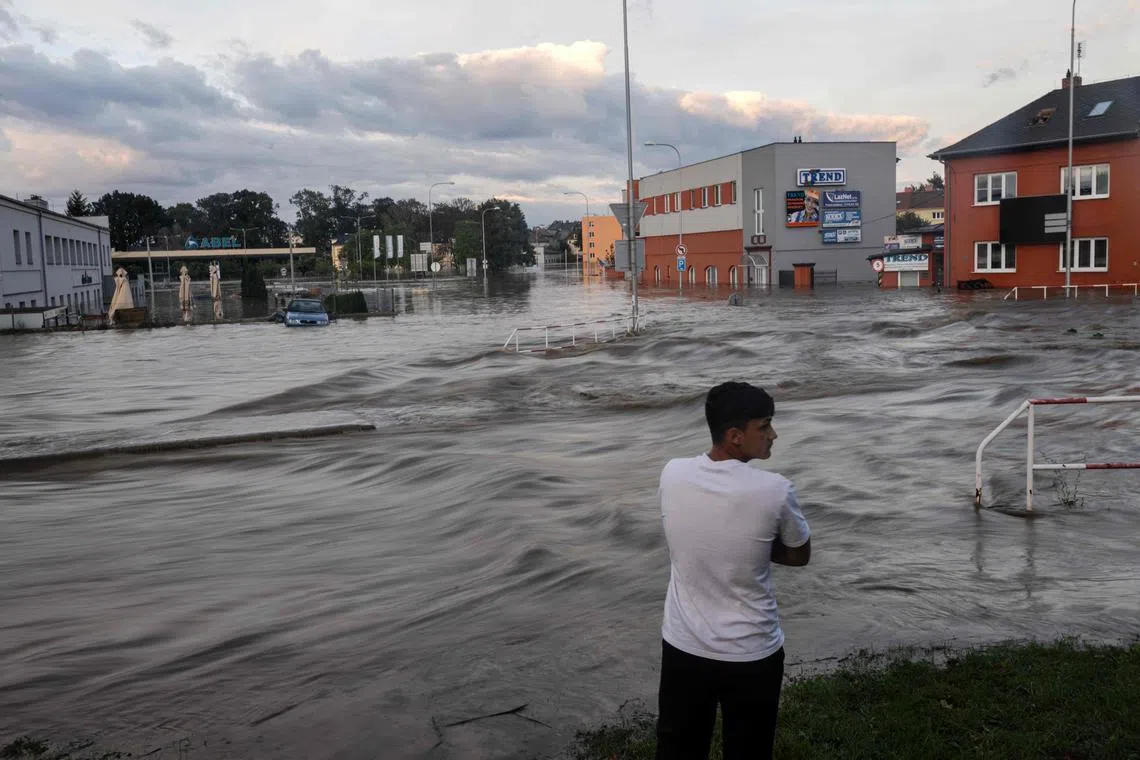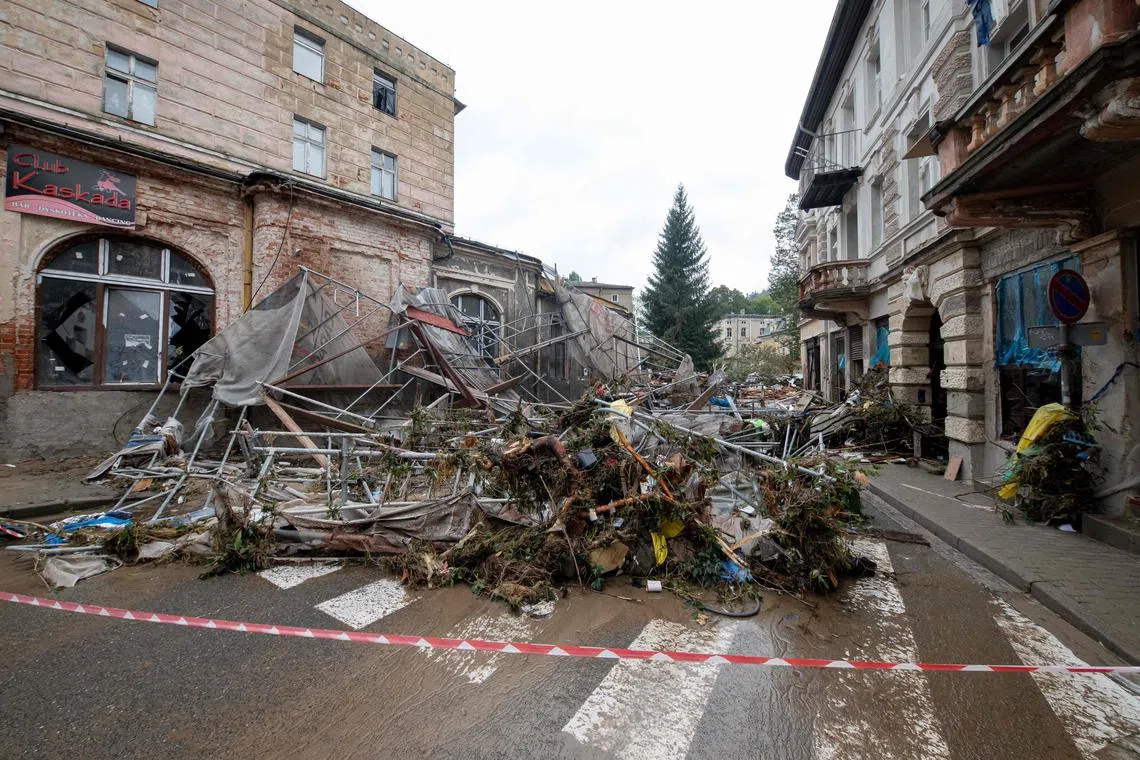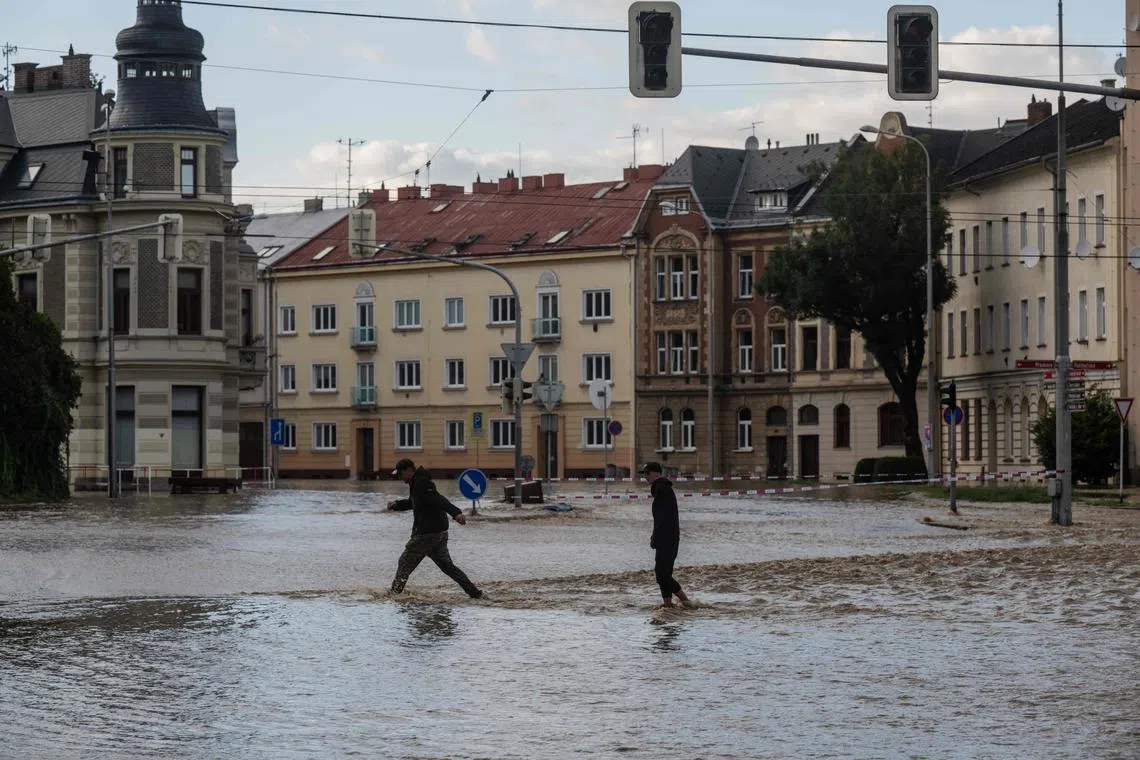What we know about the deadly floods in central Europe
Sign up now: Get ST's newsletters delivered to your inbox

A man looking at a flooded street in the Czech Republic on Sept 15. Swathes of Austria, the Czech Republic, Hungary, Romania and Slovakia have been hit by high winds and unusually fierce rainfall.
PHOTO: AFP
Follow topic:
At least 17 people were dead and several others missing on Sept 16 after days of flooding in Central Europe. Thousands were displaced, and with heavy rains continuing in some places, officials feared there could be more destruction ahead.
The floodwaters have ravaged towns, destroyed bridges and breached dams since intense rainfall from Storm Boris
For some, the disaster recalled the devastating floods that struck the region in July 1997, killing more than 100 people and driving thousands of others out of their homes.
“This was a very traumatic one for Poland – the one that is remembered,” Mr Hubert Rozyk, a spokesman for Poland’s Ministry of Climate and Environment, said of that disaster. “And in some places, the situation is even worse than in 1997.”
Here is what we know about the destruction in some of the worst-hit countries.
Romania
Seven people have died in Romania, Dr Raed Arafat, the head of the Department for Emergency Situations in the Ministry of Internal Affairs, said in a phone call on Sept 16.
All of the deaths occurred overnight from Sept 13 to 14 and all in Galati County, he said, which is on the eastern border with Moldova.
A preliminary evaluation found that about 5,500 households in Galati were affected by floods.
In Vaslui County, which is directly to the north, about 120 households were affected, he said.
He said it was “one of the worst floods in recent memory, especially for that area”.
Romania’s environment minister, Mr Mircea Fechet, told the Associated Press that some areas had received more than 160 litres of rainfall per sq m.
“What we are trying to do right now is save as many lives as possible,” he said.
Poland

Debris next to damaged buildings following floods in Ladek-Zdroj, southern Poland, on Sept 16.
PHOTO: AFP
At least five people have died, Mr Piotr Blaszczyk, a spokesperson for the government security centre, wrote in an e-mail on Sept 16.
He said the government had not yet confirmed if their deaths were “directly connected to the catastrophic flooding”, but that initial reports suggested that they were found in “areas severely impacted by rising water levels”.
Even though the storm has passed, “many rivers are still swollen, and water levels remain precariously high, threatening additional damage to infrastructure, homes, and agricultural land”, he wrote.
Some flood barriers held; others were breached to devastating effect.
Dams have been damaged or breached, including in Stronie Slaskie, a south-western town on the Morawka River, said Ms Anna Szumanska, a spokesperson for Poland’s infrastructure ministry.
“Water began to flow uncontrolled,” she wrote in an e-mail.
Mr Blaszczyk said the ground is so saturated and the water levels are so high in some rivers that there is still a risk of further flooding.
Polish officials were meeting on Sept 16 to decide whether to declare a national disaster, and Mr Blaszczyk said temporary shelters have been erected in schools and community centres.
Mr Rozyk, the climate ministry spokesperson, speaking from Opole, a city in the flooded region, said that any officials have been working for days with little rest.
“The situation is still not under control in all the places,” he said. “However, the rain stopped, so that’s good news.”
Czech Republic

People walking across a flooded street in Opava, Czech Republic, on Sept 15.
PHOTO: AFP
Mr David Schön, a spokesperson for the Czech police, said at least two people had been killed in the floods and 12 were missing.
He said in an e-mail that more than 12,000 people had been evacuated in the Moravian-Silesian region, the Olomouc region and the South Moravian region, all in the east.
Austria
At least three people have been killed in Austria, according to Mr Paul Eidenberger, a press officer for the interior ministry.
One, a volunteer firefighter, died when he slipped on the stairs while pumping water out of a basement, Mr Eidenberger said in an e-mail.
Two older men also died, apparently after being trapped inside their homes, he said.
The flooding has affected communities throughout the country, but “the most significant problems, damage and flooding” are in Lower Austria, the state that surrounds Vienna, he said.
Vienna, which has about two million people, has also been hard hit.
Public transit has been suspended or severely restricted, and the river “has become a raging torrent – normally, it carries only a few centimetres of water”, Mr Eidenberger wrote.
Hundreds of people have been rescued from rooftops by helicopter.
Mr Eidenberger said tens of thousands of volunteers had been deployed across the country, about 20,000 in Lower Austria alone.
Dams are still threatening to overflow.
“That’s the most difficult situation right now,” said Mr Markus Duerauer, a liaison officer of the Lower Austrian Fire Brigade Association.
And the rain is still coming down hard.
“Relief is not expected to come before tomorrow, and more likely, the day after,” Mr Eidenberger wrote on the morning of Sept 16. NYTIMES

